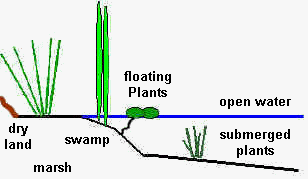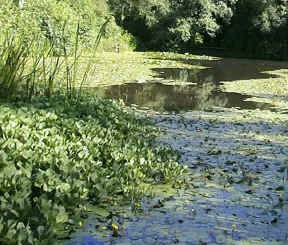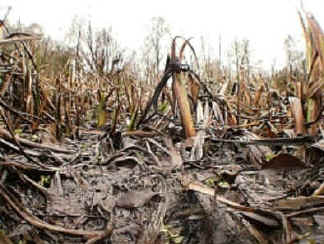Plant Zonation in Wetlands
 |
 |
Anything more than a cursory glance at a wetland will reveal that the plants are not indiscriminately placed. They are arranged in distinct, although often overlapping zones. These zones, moving from dry land to open water, encompass: . |
|
||||||||
| Dry Land | Marsh Plants | Swamp Plants | Rooted Floating Plants |
Free Floating Plants | Submerged Plants | |||
| Adaptations | Adaptations | Adaptations | Adaptations | Adaptations | Adaptations | |||
The succession of different plant
species can also be observed over a period of time in individual areas of a wetland. The
plants established in a particular region will continually affect their immediate
environment, subtly altering the local environmental conditions. This happens through
processes such as the trapping of silt in roots and old leaf bases. This raises the level
of the land, making it drier and gradually transforming it into an area more suited to a
different set of plant species. Wetland Development Open water must be shallow enough for submerged
plants to become established. If it is too deep the light penetrating to the bottom is
insufficient for plant growth. Plants such as Canadian Pondweed and Water Milfoil colonise
these shallow open water regions at depths of up to 3 metres. As time passes, silt becomes
trapped among the roots and old leaf bases of these plants, gradually raising the level of
the bottom. This allows rooted plants with floating leaves to become established. These
include plants such as Water Lilies. These can only become established where the water is
shallow enough to allow the leaves to reach the surface. Water Lilies usually grow where
the water is 0.5 - 2.0 metres deep, although Yellow Water Lilies have been recorded from
depths of up to 3.6m. Other floating leaved plants such as Broad-leaved Pondweed are
generally found in water of moderate depth, from 1 - 2 m deep. |
 |
As they become established, the floating leaved plants gradually shade out the underlying submerged plants. Stands of Water Lilies can form a complete floating carpet of leaves on the water surface, producing a layer sturdy enough for Moorhens to run over. |
The roots and leaf bases of these plants also trap additional silt, further raising the level of the underlying sediment. This allows emergent swamp plants such as Yellow Iris and Branched Bur-reed to invade and colonise the area. |
 |
These species die back in
winter and the old leaves and tough fibrous rhizomes
provide an extraordinarily efficient trapping area for sediment entering the wetland in
floodwater or in rainfall run-off. This raises the land level sufficiently for marsh plants to become established. This continual succession process may extend over several years until eventually dry land exists where once there was open water and wetlands. |
| Trees such as Alder and Willow will colonise areas which are drying out, transforming them into wet woodland or Carr. | |
Offwell Wetland
Line Transect Diagrams
Plant Adaptations to Aquatic Life